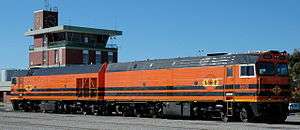Commonwealth Railways NJ class
The NJ class are a class of diesel locomotive built in 1971 by Clyde Engineering, Granville for the Commonwealth Railways for use on the Central Australia Railway.
| Commonwealth Railways NJ class | |||||||||||||||||||
|---|---|---|---|---|---|---|---|---|---|---|---|---|---|---|---|---|---|---|---|
 Australian Railroad Group's 1605 & 1602 at Forrestfield in July 2005 | |||||||||||||||||||
| |||||||||||||||||||
| |||||||||||||||||||
| |||||||||||||||||||
| |||||||||||||||||||
History
In 1969 Commonwealth Railways ordered six single-cab NJ class locomotives from Clyde Engineering for use on the narrow gauge 1,067 mm (3 ft 6 in) Central Australian Railway between Marree and Alice Springs. They hauled freight trains as well as The Ghan passenger train. Built at Clyde Engineering's Granville factory they featured many components from the company's new Kelso factory. Their cab was similar to that of the New South Wales 422 class that had recently been built.[1]
In July 1975, all were included in the transfer of Commonwealth Railways to Australian National. Following the closure of the Central Australian Railway in December 1980 and their unsuitability for conversion to standard gauge they were transferred by Australian National to the Eyre Peninsula Railway in South Australia. After a few teething problems associated with operating at higher speeds, the class settled down and were employed hauling grain and gypsum services.[1]
All six were sold with Australian National's South Australian operations to Australian Southern Railroad in August 1997 and renumbered as the 1600 class. Some were transferred to Australian Railroad Group to operate services in Western Australia.[2][3] With the splitting up of Australian Railroad Group, two passed to Aurizon in February 2006 and four to Genesee & Wyoming Australia in June 2006.[4]
In January 2015, the two Aurizon units were exported to Durban, South Africa.[5]
In early 2019, 1604 (formerly NJ 4) was sent for scrap after being lifted onto a low-loader and hauled to Adelaide by road. The remaining locomotives (1601, 1603 and 1606) are currently operating at Thevenard on the Gypsum workings. 1603 also led the last GWA grain train to Cummins on the 31st May 2019.
Names
- NJ1 was named after prime minister Ben Chifley, a former locomotive driver from Bathurst, near Kelso where many of the locomotives' components were manufactured. As of February 2020, the locomotive now unofficially carries the name 'Thevenard' on the side of the locomotive cab, possibly reflecting the change to gypsum only traffic for the Port Lincoln division motive power.
References
Notes
- Oberg, Leon (2007). Locomotives of Australia. Sydney: Rosenberg Publishing. p. 370. ISBN 9781877058547.
- Narrow Gauge NJ Chris' Commonwealth Railways Pages
- NJ Class Railpage
- 1600 Class Railpage
- West Australian Rails Jim Bisdee
Bibliography
- Fluck, Ronald E; Marshall, Barry; Wilson, John (1996). Locomotives and Railcars of the Commonwealth Railways. Welland, SA: Gresley Publishing. ISBN 1876216018.
External links
![]()